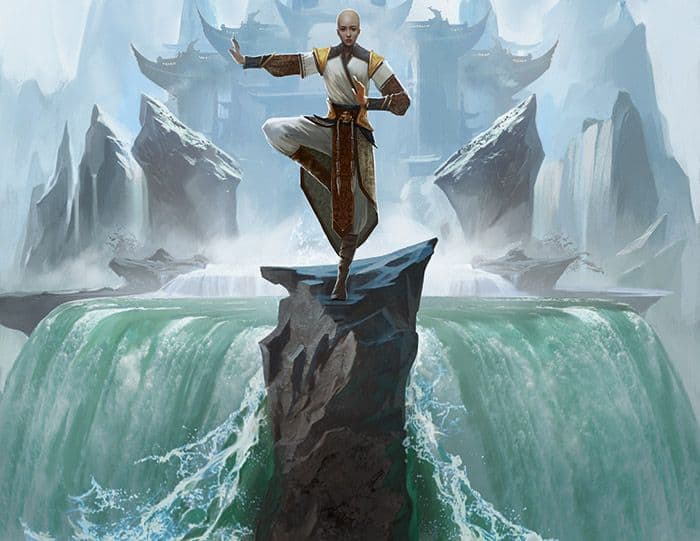For those who seek to harness the raw power of the elements, look no further than the Way of the Four Elements Monk in D&D 5e.
Using the power of their ki, these Monks can summon mighty winds, raging fires, and more. With the elements themselves under the Monk’s control, what foe can stand before them?
So if you want to be as swift as the coursing river with all the force of a great typhoon, this is your chance.
This is the full subclass guide to the Way of the Four Elements Monk in D&D 5e!
What is the Four Elements Monk?
Mechanically, the Way of the Four Elements Monk is like a hybrid between the traditional Monk and a spellcaster. This subclass offers a ton of customization as you level up and gain new Elemental Disciplines.
You don’t have to lock yourself into disciplines of a specific element type. You might unleash attacks with scorching tendrils of fire then follow up with a powerful blast of wind to blow your enemies away.
Monks who follow the tradition of the Way of the Four Elements take inspiration from nature. Through their training and discipline, these Monks can use their ki to call upon the forces of fire, water, wind, and earth to assist them.
This manifests in the form of techniques that those who are familiar with the arcane arts might recognize.
However, the Monk isn’t mixing reagents to produce these spell effects like a Wizard would. These effects are made possible through their sheer force of will and mastery of their own ki.
Role in the Party
As a Four Elements Monk, you’re a bit of an odd duck. Most Monks are skirmishers who are meant to swoop in, hit fast and often, then continue zipping around the battlefield.
But you’re not like most Monks.
The features you gain from the Way of the Four Elements subclass make you more like a caster than anything. With your limited ki resource that recharges on a short rest, you’re more akin to a Kung Fu Warlock than a sagely Wizard or naturally gifted Sorcerer.
You definitely don’t want to be sticking around the party’s back lines like a regular caster would, but you won’t be gaining many features to help you hold the frontlines.
Because the specific elemental disciplines you take are meant to mimic and enhance spell effects, your positioning is going to largely depend on what combination of disciplines you take.
With the majority of these in combination with your features from the core Monk class, you’ll likely be bobbing and weaving between the party’s front and mid sections in combat.
If a foe gets too close and out of position, you can punish them with a Flurry of Blows or Stunning Strike.
If multiple enemies line up, you can instead punish them with a high-value use of something like Burning Hands. They might expect that from the Wizard in the back, but not from you!

Way of the Four Elements Monk Features 5e
The Way of the Four Elements Monk only gains one actual feature, but they are able to customize and add to it as they level up.
It’s a little weird, but that’s what this guide is for!
Where other Monk subclasses gain features at levels 3, 6, 11, and 17, those are instead the levels at which you can attune to new Elemental Disciplines.
So we’re going to cover your sole feature then we’ll look at the Elemental Disciplines that you can take within that feature. I’ll offer some thoughts, ideas, or opinions for each of these Elemental Disciplines as well.
Also Check Out: The Full Monk Class Guide for D&D 5e!
Disciple of the Elements
Disciple of the Elements is the only actual feature that the Four Elements Monk gains.
Instead of gaining new features as you level up, you can gain new abilities within the Disciple of the Elements feature.
These abilities are called Elemental Disciplines. Most let you cast spells using your ki but some provide other effects. As you level up, more Elemental Disciplines become available to you.
By default, you know the Elemental Attunement discipline (which we’ll cover in more detail below) and one more of your choice. You gain a new discipline of your choice at level 6, 11, and 17.
Whenever you learn a new Elemental Discipline, you can also replace one of your existing Elemental Disciplines with another.
If a certain discipline isn’t getting you the same value that it did at lower levels, it’s good to look for ways to trade up. Just be mindful that you can only swap one out at a time and can only do so at levels 6, 11, and 17. Choose wisely!
There’s A LOT to this so I’m going to break the feature down as well as possible.
Elemental Spellcasting
Let’s start by covering the Four Element Monk’s spellcasting. As a Monk that also casts spells, you’re not exactly conventional so it might not be as straightforward as you may expect.
Elemental Disciplines that allow you to cast spells generally follow the typical rules of spellcasting. These spells have the same casting time, effects, etc as the spell. You’ll still have verbal and somatic components but don’t worry about the material components of these spells.
Starting at level 5, you can increase the level that you are casting a spell at. Where a typical caster would use a higher level spell slot, you instead spend more ki points to do this.
This spell must have an enhanced effect at higher levels to do this. For example, you can “upcast” Burning Hands to deal more damage but Wall of Stone has no such benefit.
For each ki point that you spend to “upcast” a spell, the spell’s level increases by 1.
Using Burning Hands again as an example, let’s say you spend 3 ki points to enhance the spell. It’s typically a level 1 spell but you’ve spent ki points to make it a level 4 spell. So instead of dealing 3d6 fire damage, it’s dealing 6d6 fire damage.
Just keep in mind that there’s a limit to the amount of ki points you can use this way. I’ll include a table below to show you the maximum number of ki points you can spend per Monk level. Note that this limit also includes the ki that you used to cast the spell in the first place.
| Monk Levels | Maximum Ki Points For Spells |
| 5 – 8 | 3 |
| 9 – 12 | 4 |
| 13 – 16 | 5 |
| 17 – 20 | 6 |
So the use of Burning Hands in the above example would cost 2 ki points (from the Sweeping Cinder Strike discipline to cast it) plus an extra 3 ki points to buff it. That’s a total of 5 ki points which means it’s the maximum that a Four Elements Monk of level 13 to 16 can spend on the spell.
Elemental Attunement
Think of this as an elemental version of the prestidigitation cantrip.
Using your action, you’re able to briefly control the forces of the elements near you. These are smaller effects that can be used for flavor or possibly in some very creative ways depending on the situation.
Examples include:
- Create a harmless, instantaneous sensory effect related to air, earth, water, or fire. (A puff of wind, gentle stone rumbling, shower of sparks, or a light mist.)
- Instantly light or snuff out a candle, torch, or small campfire.
- Chill or warm up to 1 pound of nonliving material for up to 1 hour. (Every party needs a microwave/refrigerator right?)
- Shape earth, fire, water, or mist within a 1 foot cube into a crude form of your choice for 1 minute.
All in all, this isn’t anything particularly special but at least it’s free, right?

Level 3 Elemental Disciplines
For the level that you’re getting these at, they’re okay. As you level up, you’ll definitely be looking to replace whichever one you take though.
Fangs of the Fire Snake
Look out! These fangs were made for biting and that’s just what they’ll do.
When you use the Attack action on your turn, you can spend 1 ki point to cause tendrils of flame to stretch out from your fists and feet.
Your reach with your unarmed strikes increases by 10 feet for that action, as well as the rest of the turn.
A hit with such an attack deals fire damage instead of bludgeoning damage. If you spend 1 ki point when the attack hits, it also deals an extra 1d10 fire damage.
Gaining an extra 10 feet of reach is pretty cool and pumping out so much extra fire damage in the game is pretty nifty in most cases. You’ll definitely have much less trouble with flying enemies like Harpies and have a pretty reliable way around creatures that would otherwise resist bludgeoning damage.
The downside is that this gets expensive very quickly.
At the lower levels, you don’t have many ki points to throw around. Spending one ki point for your fire tendrils and another to bump its damage is costly. Especially if you’re trying to mix in a Flurry of Blows, you’ll be tapped for ki within a couple of rounds.
This is a decent option, just keep an eye on your ki points.
Fist of the Four Thunders
2 ki points to cast Thunderwave isn’t a bad deal if you’re getting overwhelmed. This deal some decent damage in addition to pushing enemies away if they fail their Constitution saving throw.
If you find yourself needing some elbow room, this can be a great defensive option. By the same token, if you think the enemies might not be so good at Constitution saves, it could instead be used offensively to drop several of them at once.
If only for the insurance it provides, I’d say this is one of the standout options for your early-level Elemental Disciplines.
Fist of Unbroken Air
If sending enemies flying is your jam, you’ve got options.
As an action, spend 2 ki points and choose a creature within 30 feet of you. That creature must make a Strength saving throw.
On a failed save, the creature takes 3d10 bludgeoning damage, plus an extra 1d10 bludgeoning damage for each additional ki point you spend. You can also push the creature up to 20 feet away from you and knock it prone.
On a successful save, the creature takes half as much damage, and you don’t push it or knock it prone.
Feel free to yell “Fus Ro Dah!” while you use this.
Especially at lower levels, this damage can be incredibly punishing.
If you’re good at positioning, this can also be used very strategically to let your party’s melee combatants dogpile the enemy that is now prone.
Likewise, if you’re up on a mountain or scaffolding, this can be an instant-win ability as the enemy takes an incredible amount of falling damage for getting knocked to their doom.
The problem is that this is very expensive. You want to avoid using it on enemies with a high Strength score, but even then, there’s still a chance a weaker enemy will make the save.
It’s up to you if the potential reward outweighs the cost. It’s a decent ability especially if you can use it strategically and plan on taking a short rest to recover your ki soon after.

Rush of the Gale Spirits
Like I said, you’ve got options for how to send enemies flying. With this, you can spend 2 ki points to cast Gust of Wind.
This is probably the most situational option at this level. Generally speaking, I would go with Fist of Unbroken Air or Fist of the Four Thunders instead though. There’s way more “oomph” for the ki cost with those.
Shape the Flowing River
This Elemental Discipline adds some extra utility to the Four Elements Monk’s kit.
As an action, you can spend 1 ki point to choose an area of ice or water no larger than 30 feet on a side within 120 feet of you.
You can change water to ice within the area and vice versa, and you can reshape ice in the area in any manner you choose.
You can raise or lower the ice’s elevation, create or fill in a trench, erect or flatten a wall, or form a pillar. The extent of any such changes can’t exceed half the area’s largest dimension.
Ice cannot be shaped to trap or damage a creature in the area.
This is useful when the environment a player’s creativity are able to work together to massive effect. Even though you can’t trap enemies in an icy tomb, you can still do all kinds of shenanigans in 15ft increments.
In a campaign with lots of water (like a pirate adventure or many aquatic areas in Call of the Netherdeep), you can go absolutely crazy with this. Imagine being in a naval battle and creating a 30ft ice block to destroy the hull of the enemy’s ship!
Otherwise, it’s more on the “meh” side of things. It’s good to have when you need it, but you have a limited number of Elemental Disciplines so only pick this if you know you’re going to get consistent value out of it.
Sweeping Cinder Strike
If you’re feeling more fired up, Sweeping Cinder Strikes lets you spend 2 ki points to cast burning hands.
This isn’t necessarily bad. Burning Hands is a good Area of Effect spell with some decent damage.
Honestly, my biggest critique of this Elemental Discipline is that the Sun Soul Monk can do the same thing except theirs only uses a bonus action.
Personally I’m a bit more partial to the knockback effect of Fist of the Four Thunders which also does similar damage.
Water Whip
Spend 2 ki points as an action to create a whip of water that shoves and pulls an enemy. A creature that you can see that is within 30 feet of you must make a Dexterity saving throw.
On a failed save, the creature takes 3d10 bludgeoning damage, plus an extra 1d10 bludgeoning damage for each additional ki point you spend, and you can either knock it prone or pull it up to 25 feet closer to you.
On a successful save, the creature takes half as much damage, and you don’t pull it or knock it prone.
This works pretty similar to Fist of Unbroken Air except you’re pulling them towards you instead of knocking them away.
Just like with Fist of the Unbroken Air, this is best used strategically.
Pulling a squishier enemy (like a caster) closer to your party’s heavy hitters is a quick way to take them off the field. You could also use this to pull enemies into traps or environmental hazards. Additionally, you could use this to bring a flying enemy into melee range for the party to focus them down.
If you’re good at coordinating with your party, this is an excellent option for you.

Level 6 Elemental Disciplines
When you hit level 6, you gain a new Elemental Discipline. In this case, you have two options.
Also, don’t forget that now is the time to trade out your previous Elemental Discipline if you feel you could do better!
Recommended: Mastering Monk Weapons in D&D 5e
Clench of the North Wind
With this discipline, you can spend 3 ki points to cast Hold Person.
Keep in mind that at level 5 you’ve already gotten the Monk’s strongest feature from the core class: Stunning Strike. Being able to stun a creature for a round is vicious.
But Clench of the North Wind is absolutely the option you should be taking at level 6. While it may seem redundant, just trust me on this.
With the Paralyzed condition, creatures within 5 feet of the paralyzed creature are automatically dealing critical hits with their attacks. With your attacks at advantage because of the paralyzed creature’s condition, this is an incredibly “set and spike” for your team.
Additionally, it’s a Wisdom saving throw to resist this instead of a Constitution save like Stunning Strike. If you’re going against something like a Hill Giant with a high Constitution score but a low Wisdom, you’ve got a reliable trick up your sleeve.
Gong of the Summit
Spending 3 ki points to cast Shatter just doesn’t have the same “oomph” to it as Clench of the North Wind.
Sure, it’s a decent option if you’re fighting Golems or other inorganic creatures that would have disadvantage on their save.
But save that level of preparedness for the Wizard, Sorcerer, or Bard. You don’t have the slots to prepare for fringe cases and this just doesn’t work as well for you in the vast majority of cases.
Certainly compared to your other option at this level, this isn’t anything spectacular.
Level 11 Elemental Disciplines
You’ve got some decent options here, but one certainly stands out among the rest.
Once again, this is your last chance until level 17 to swap out an Elemental Discipline that you don’t use that much for something else!
Flames of the Phoenix
It’s time for everybody’s favorite crowd-clearing spell!
With Flames of the Phoenix, you can spend 4 ki points to cast Fireball.
This is the go-to blaster spell if there ever was one. Great damage in a large area, what’s not to love?
Well, unfortunately you’re a little late to the party as a Four Elements Monk. Odds are pretty good that your party’s Wizard or Sorcerer has been doing this for 5 levels now.
That 8d6 damage just doesn’t hit quite the same as it used to. Even if you are a level 17 or higher Four Elements Monk, you’re only bumping that to 10d6.
This isn’t bad by any stretch of the imagination. Just temper your expectations if you’re taking this Elemental Discipline. It’s good but hardly your highest-value option of the level 11 disciplines.
Mist Stance
If you find yourself in a bind, Mist Stance lets you spend 4 ki points to cast Gaseous Form on yourself.
This is a great pick if you find yourself doing most of the party’s scouting. Because you’re literally turning into a misty cloud, you’re an exceptional infiltrator. Likewise, you can make a clever escape if a situation turns south with this.
If your party already has someone already handling recon work for the group, you’re better off passing on this.
Ride the Wind
Monks rely on having a high mobility which makes Ride the Wind my pick for the best level 11 Elemental Discipline.
With this, you can spend 4 ki points to cast Fly on yourself.
You’ll have no problem outmaneuvering just about any enemy or obstacle you face with this.

Level 17 Elemental Disciplines
At last we come to the final selection of Elemental Disciplines. These represent the highest level of attunement with the elements through your continued practice and discipline.
As such, there’s not really clear “best” and “worst” picks. Consider your character’s role and the party’s composition to fill in accordingly. By this level, you should have a good idea what will work best with the party.
This is also your final opportunity to swap out any Elemental Disciplines that aren’t working for you anymore. You’re in the highest tier of play now so gear up accordingly!
Just don’t make the mistake of going all-in on these higher-level disciplines. They’re powerful but have a ki cost to match. You don’t want to find yourself chewing through all your ki points in just a few rounds.
Having a mix of higher and lower level disciplines is best!
Breath of Winter
With Breath of Winter, you can spend 6 ki points to cast Cone of Cold.
This is one of my favorite spells in D&D 5e. Great damage in a massive 60 ft cone can make for a highly impactful spell. If things are getting all mixed up in combat, this can let you really take advantage of an opening without nuking your allies in the process.
The biggest drawback to this is that it’s a Constitution saving throw instead of a Dexterity save like with Fireball. At this higher level, enemies tend to be much tougher.
It can still be great for cleaning up the minions, but it’s pretty likely that the heavy hitters you’re facing will be making their saves.
For the ki, you’re probably better off with the fireball you get from Flames of the Phoenix. Though combining this with Ride the Wind from the previous set of disciplines could really let you hit enemies hard from some unexpected angles if you prefer to play more strategically.
Eternal Mountain Defense
With Eternal Mountain Defense, you can spend 5 ki points to cast Stoneskin on yourself.
Monks, even those with caster abilities like the Four Elements Monk, favor getting up close and personal with enemies. Having resistance to nonmagical bludgeoning, piercing, and slashing damage can potentially half all of the damage you’re taking in a combat.
Monks aren’t typically the hardiest class since they favor speed over outright toughness. This is an excellent way to boost your survivability!
River of Hungry Flame
Firebenders rejoice! With River of Hungry Flame, you can spend 5 ki points to cast Wall of Fire.
This is a great spell that can deal some solid Area of Effect damage while also offering some defensive utility.
The big draw here is that you can snake and position the wall however you need to. Want to really turn up the heat on a group of enemies? Cue the Johnny Cash music and send them down, down, down in a burning ring of fire!
Wave of Rolling Earth
If I had to pick a favorite Elemental Discipline at this level, it would be Wave of Rolling Earth. With this, you can spend 6 ki points to cast Wall of Stone.
In my experience, at least, so many players tend to ignore or sleep on this spell. That’s a colossal shame!
There’s an endless list of ways that you can use this creatively.
As you probably expect, it’s great for defense. Even if an enemy is strong enough to break through your wall, only the strongest will be able to break through like the Kool-Aid Man.
Whether you need to trap your enemies or cover your own escape, there’s nothing you can’t do with a wall of solid stone.
As with the Wall of Fire, you can place and maneuver this however you need to!

Connections
There’s a ton of theming that you can work with when making a Four Elements Monk.
If you’re focusing on a particular element, that may be related to the Monastery that you learned at.
For example, a Fire Monk might have studied at a monastery nestled on a volcano. A Wind Monk’s home monastery could be located in the eye of an eternal storm somewhere deep in an expansive desert.
Additionally, your body might be adorned in tattoos related to specific elements that you harness. This is very common among Way of the Four Elements Monks. You might even be able to get magic tattoos in time!
| Element | Tattoo Images |
| Fire | Phoenix, the Sun, Fire |
| Earth | Mountains, Trees |
| Water | Fish, Tidal Waves, Krakens |
| Air | Clouds, “Wind-like” linework |
But what spurred them towards their adventure away from their home monastery?
Maybe one day the volcano went dormant or the winds stopped as an omen of grave things to come. Sent to investigate the world beyond the monastery, does your master expect you to return with news of the events of the outside world?
Perhaps you’ve been able to strike up a friendship with Druids who are also attuned to the elements. A friendship between a Four Elements Monk and a Circle of Wildfire Druid would certainly be a sight to behold!
Of course, this is also the perfect chance to bring in themes from Avatar: The Last Airbender if you’re so inclined!
Is the Way of the Four Elements Monk Good?
The Way of the Four Elements Monk tries to be a lot of things but doesn’t really succeed at any of them. I try to be a “glass half full” kind of person, but there’s just not a strong case for this Monastic Tradition.
With so much potential on paper, the Way of the Four Elements is ultimately a very disappointing subclass to play. Maybe useful in some niche situations, but too limited to really be effective.
As a semi-caster, the Four Elements monk suffers mostly from an extremely limited spell list. You will always feel much weaker than your party’s other casters who can cast spells much earlier than you.
To make it worse, you don’t have much to separate you from the standard Monk in combat. Where other Monk subclasses are getting unique features that enhance aspects of how they play their role in the party, you’re just kind of stuck in limbo.
The value for your spells just isn’t there. In so many situations, your ki points are much more efficiently spent on features like flurry of blows or stunning strike.
The Four Elements Monk has got great style and theme (some of the coolest of the Monk subclasses) but it falls a bit short on substance.
Considering a different Monk subclass or just want to see for yourself? Make sure you check out the full ranking of every Monk subclass in D&D 5e!
Conclusion – The Way of the Four Elements Monk in D&D 5e
Whew… There’s a lot to the Way of the Four Elements Monk. I think this might have been the lengthiest guide I’ve written to date.
It’s got a great overall style and theme. I just truly wish it had more to offer mechanically.
For the record, I think it’s absolutely possible to play a Way of the Four Elements Monk and enjoy it. I hate feeling like I’m just trashing a subclass altogether, but I just can’t consider it as viable as the other options available to Monks.
At the very least, in the situations where these Monks are useful, they’re INCREDIBLY useful.
What do you think? Let’s chat in the comments!
Want all the latest player guides, DM tips, news, reviews, and more for D&D 5e? Sign up for the Tabletop Joab newsletter below!
You can also follow me on Facebook and Twitter.
If you found this article helpful and want to support the site, you can buy me a coffee here! (It’s not expected, but very appreciated!)









